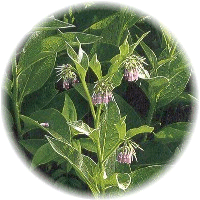
Symphytum officinale

Symphytum officinale
Synonyms - Borraja, Bourrache, Buyuk Karakafesotu, Consoude, Consuelda, Hirehari-So, Liane Chique
Description - The leafy stem, 2 to 3 feet high, is stout, angular and hollow, broadly winged at the top and covered with bristly hairs. The lower, radical leaves are very large, up to 10 inches long, ovate in shape and covered with rough hairs which promote itching when touched. The stem-leaves are decurrent, i.e. a portion of them runs down the stem, the body of the leaf being continued beyond its base and point of attachment with the stem. They decrease in size the higher they grow up the stem, which is much branched above and terminated by one-sided clusters of drooping flowers, either creamy yellow, or purple, growing on short stalks. These racemes of flowers are given off in pairs, and are what is known as scorpoid in form, the curve they always assume suggesting, as the word implies, the curve of a scorpion's tail, the flowers being all placed on one side of the stem, gradually tapering from the fully-expanded blossom to the final and almost imperceptible bud at the extremity of the curve, as in the Forget-meNot. The corollas are bell-shaped, the calyx deeply five-cleft, narrow to lance-shaped, spreading, more downy in the purpleflowered type. The fruit consists of four shining nutlets, perforated at the base, and adhering to the receptacle by their base. Comfrey is in bloom throughout the greater part of the summer, the first flowers opening at the end of April or early May.
Habitat and Cultivation - An indigenous European plant, comfrey grows in all temperate regions of the world, including western Asia, North America, and Australia. Comfrey thrives in moist, marshy places. Comfrey can be grown from seed in spring or by root division in autumn, and the leaves and flowering tops are harvested in summer. The root is unearthed in autumn.
Medicinal use - Demulcent, mildly astringent and expectorant. As the plant abounds in mucilage, it is frequently given whenever a mucilaginous medicine is required and has been used like Marshmallow for intestinal troubles. It is very similar in its emollient action to Marshmallow, but in many cases is even preferred to it and is an ingredient in a large number of herbal preparations. It forms a gentle remedy in cases of diarrhoea and dysentery.
For its demulcent action it has long been employed domestically in lung troubles and also for quinsy and whooping-cough. The root is more effectual than the leaves and is the part usually used in cases of coughs. It is highly esteemed for all pulmonary complaints, consumption and bleeding of the lungs. A strong decoction, or tea, is recommended in cases of internal haemorrhage, whether from the lungs, stomach, bowels or from bleeding piles -to be taken every two hours till the haemorrhage ceases, in severe cases, a teaspoonful of Witch Hazel extract being added to the Comfrey root tea.
Comfrey leaves are of much value as an external remedy, both in the form of fomentations, for sprains, swellings and bruises, and as a poultice, to severe cuts, to promote suppuration of boils and abscesses, and gangrenous and ill-conditioned ulcers . The whole plant, beaten to a cataplasm and applied hot as a poultice, has always been deemed excellent for soothing pain in any tender, inflamed or suppurating part. It was formerly applied to raw, indolent ulcers as a glutinous astringent. It is useful in any kind of inflammatory swelling.
Pharmacology:
Some of the compounds in Comfrey are:
Parts to use - The leaves and roots. Comfrey contains significant levels of PA, and the concentration is considerably greater in the root than in the leaves. Studies in mice and humans have shown persistent exposure to PA through comfrey ingestion has caused veno-occlusive liver disease. Comfrey can be an effective analgesic when applied topically, as systemic absorption through the skin is minimal.
Contra-indications - One of the biggest problems is that people accidentally collect foxglove instead of comfrey. Foxglove is deadly. Among other things, it can cause irregular heart beats and convulsions. Comfrey should be taken medicinally for a short limited time only - and not when pregnant. Excessive intake can cause liver toxicity and using comfrey internally is subject to legal restriction in certain countries.